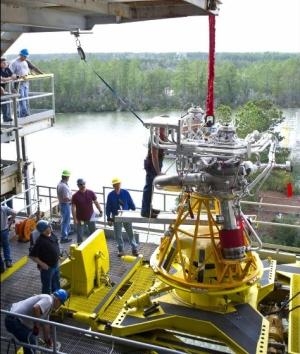Fri, Jan 27, 2012
First New 'Human Rated' Engine To Be Developed In Four
Decades
A new series of tests on NASA's new J-2X engine will begin next
week at NASA's Stennis Space Center in southern Mississippi. NASA
says the tests on the engine bring it one step closer to the first
human-rated liquid oxygen and liquid hydrogen rocket engine to be
developed in 40 years.

Tests will focus on the powerpack for the J-2X. This
highly efficient and versatile advanced rocket engine is being
designed to power the upper stage of NASA's Space Launch System, a
new heavy-lift launch vehicle capable of missions beyond low-Earth
orbit. The powerpack comprises components on the top portion of the
engine, including the gas generator, oxygen and fuel turbopumps,
and related ducts and valves that bring the propellants together to
create combustion and generate thrust. "The J-2X upper stage engine
is vital to achieving the full launch capability of the
heavy-lift Space Launch System," said William Gerstenmaier, NASA's
associate administrator for the Human Exploration and Operations
Mission Directorate. "The testing today will help ensure that a key
propulsion element is ready to support exploration across the solar
system."
About a dozen powerpack tests of varying lengths are slated now
through summer at Stennis' A-1 Test Stand. By separating the engine
components -- the thrust chamber assembly, including the main
combustion chamber, main injector and nozzle -- engineers can more
easily push the various components to operate over a wide range of
conditions to ensure the parts' integrity, demonstrate the safety
margin and better understand how the turbopumps operate.
"By varying the pressures, temperatures and flow rates, the
powerpack test series will evaluate the full range of operating
conditions of the engine components," said Tom Byrd, J-2X engine
lead in the SLS Liquid Engines Office at NASA's Marshall Space
Flight Center in Huntsville, Ala. "This will enable us to verify
the components' design and validate our analytical models against
performance data, as well as ensure structural stability and verify
the combustion stability of the gas generator."
This is the second powerpack test series for J-2X. The powerpack
1A was tested in 2008 with J-2S engine turbomachinery originally
developed for the Apollo Program. Engineers tested these heritage
components to obtain data to help them modify the design of the
turbomachinery to meet the higher performance requirements of the
J-2X engine. "The test engineers on the A-1 test team are excited
and ready to begin another phase of testing which will provide
critical data in support of the Space Launch System," said Gary
Benton, J-2X engine testing project manager at Stennis.
More News
Circle To Runway (Runway Number) Used by ATC to inform the pilot that he/she must circle to land because the runway in use is other than the runway aligned with the instrument appr>[...]
Aero Linx: National Aviation Safety Foundation (NASF) The National Aviation Safety Foundation is a support group whose objective is to enhance aviation safety through educational p>[...]
At Altitude Of About 250-300 Ft Agl, The Airplane Experienced A Total Loss Of Engine Power On November 6, 2024, at 1600 central standard time, a De Havilland DHC-1, N420TD, was inv>[...]
From 2009 (YouTube Edition): Three Hour Flight Was 'Flawless' -- At Least, Until Mother Nature Intervened For anyone who loves the aviation business, this was a VERY good day. Afte>[...]
Also: AMA Names Tyler Dobbs, More Falcon 9 Ops, Firefly Launch Unsuccessful, Autonomous F-16s The Air Force has begun ground testing a future uncrewed jet design in a milestone tow>[...]
 ANN's Daily Aero-Term (05.05.25): Circle To Runway (Runway Number)
ANN's Daily Aero-Term (05.05.25): Circle To Runway (Runway Number) ANN's Daily Aero-Linx (05.05.25)
ANN's Daily Aero-Linx (05.05.25) NTSB Prelim: De Havilland DHC-1
NTSB Prelim: De Havilland DHC-1 Classic Aero-TV: The Boeing Dreamliner -- Historic First Flight Coverage
Classic Aero-TV: The Boeing Dreamliner -- Historic First Flight Coverage Airborne-NextGen 05.06.25: AF Uncrewed Fighters, Drones v Planes, Joby Crew Test
Airborne-NextGen 05.06.25: AF Uncrewed Fighters, Drones v Planes, Joby Crew Test



